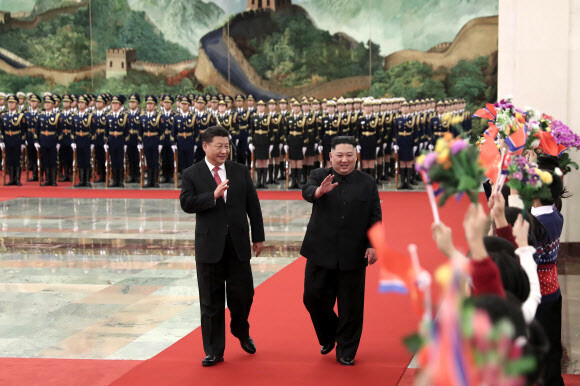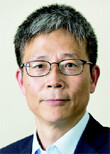hankyoreh
Links to other country sites 다른 나라 사이트 링크
[Column] Letting the clock run out won’t work to the US’ advantage

North Korean leader Kim Jong-un has ventured into the outside world once more. His personal train took him the 14 hours from Dandong to Beijing, where he held his fourth summit with Chinese President Xi Jinping. That sends a stronger message to the outside world than staying still.
After Kim’s New Year’s address and his visit to China, the ball will be in the US’ court. Although US President Donald Trump announced that the location of his summit with Kim will be announced before long, we will eventually again find ourselves at the point where everything depends on the officials who are supposed to carry out Trump’s wishes. That’s especially true since the agenda of the second North Korea-US summit is likely to be deliberated before the time and location are decided, in contrast with the first summit, in which the time and location were chosen before the agenda was discussed.
Though there’s speculation in some quarters about a change in the lineup, for the moment US Secretary of State Mike Pompeo is likely to continue representing the US in its negotiations with North Korea. The people he meets in the US, the strategy he draws up and the way he shares all that with Trump will have a considerable impact on future working-level and high-level negotiations between the two sides and on the mood of the summit itself.
Two-faced Pompeo
Strictly considering the negotiations with North Korea, there appear to have been two Pompeos thus far. There was the initial Pompeo, who faithfully carried out Trump’s will, and there is the current Pompeo, who has been tamed by mainstream diplomats in Washington.
The watershed point was the Kim-Trump summit in Singapore on June 12, 2018. Prior to the Singapore summit, Pompeo had visited North Korea on two occasions, once as director of the CIA from Mar. 31 to Apr. 1, and once as secretary of state on May 9. Pompeo exhibited a considerable amount of flexibility while paving the way to the first North Korea-US summit in history.
But there has also been another Pompeo. This is the Pompeo that we witnessed when he visited North Korea for the third time in July 6-7, 2018, for the first follow-up deliberations to the Singapore summit, and when he made his fourth visit to the North on Oct. 7. Pompeo’s third visit in particular was a serious reversal of the progress made during the Singapore summit and almost sent negotiators back to square one. Facing criticism from both inside and outside the US government that the US had made too many concessions to North Korea during the Singapore summit, Pompeo returned to the North determined to deal with the North Koreans as his critics had recommended. Pompeo raised the bar by declaring that there would be no end-of-war declaration until the North handed over a list of its nuclear facilities and weapons, leading to a public exchange of harsh words and actions.
The damage inflicted by Pompeo’s third visit to North Korea was so severe that the situation couldn’t be turned around by South Korean President Moon Jae-in’s visit to Pyongyang in September or by Pompeo’s subsequent fourth visit to the North. It’s no exaggeration to say that the US has kept its basic policy toward North Korea basically the same since then. North Korea has expressed its distaste for Pompeo, and the US is uncomfortable with Kim Yong-chol.
North Korea’s realization for a need for a contingency plan
The lesson that North Korea has learned from this process appears to be the need for a contingency plan in case this standoff becomes protracted. The North appears to be hurrying to prepare a response to the US’ remarks about “patience” and there being “no rush.” That’s why Kim placed such an emphasis on “self-reliance” in his New Year’s address.
If only the effect of the sanctions could be blunted, the passage of time could make North Korea’s possession of its current nuclear arsenal a fait accompli. Given that possibility, Kim’s reference to “a new way” might refer to maintaining the status quo. Watching the political chaos in the US, the North Koreans may also believe that playing for time could enable them to seize the upper ground in negotiations with the US.

There’s a pattern in which Kim visiting China is followed by Pompeo visiting North Korea. It’s too soon to say whether Pompeo will visit the North this time, too. If he does visit the North or meets North Korean negotiators, however, he ought to forget about the secret techniques for taming North Korea that he wrote down in his notebook before his third visit to the North. Letting the clock run out isn’t likely to work to the US’ advantage.
By Yi Yong-in, Korean Peninsula affairs editor
Please direct comments or questions to [english@hani.co.kr]

Editorial・opinion
![[Column] Season 2 of special prosecutor probe may be coming to Korea soon [Column] Season 2 of special prosecutor probe may be coming to Korea soon](https://flexible.img.hani.co.kr/flexible/normal/500/300/imgdb/original/2024/0426/3317141030699447.jpg) [Column] Season 2 of special prosecutor probe may be coming to Korea soon
[Column] Season 2 of special prosecutor probe may be coming to Korea soon![[Column] Park Geun-hye déjà vu in Yoon Suk-yeol [Column] Park Geun-hye déjà vu in Yoon Suk-yeol](https://flexible.img.hani.co.kr/flexible/normal/500/300/imgdb/original/2024/0424/651713945113788.jpg) [Column] Park Geun-hye déjà vu in Yoon Suk-yeol
[Column] Park Geun-hye déjà vu in Yoon Suk-yeol- [Editorial] New weight of N. Korea’s nuclear threats makes dialogue all the more urgent
- [Guest essay] The real reason Korea’s new right wants to dub Rhee a founding father
- [Column] ‘Choson’: Is it time we start referring to N. Korea in its own terms?
- [Editorial] Japan’s rewriting of history with Korea has gone too far
- [Column] The president’s questionable capacity for dialogue
- [Column] Are chaebol firms just pizza pies for families to divvy up as they please?
- [Column] Has Korea, too, crossed the Rubicon on China?
- [Correspondent’s column] In Japan’s alliance with US, echoes of its past alliances with UK
Most viewed articles
- 1‘We must say no’: Seoul defense chief on Korean, USFK involvement in hypothetical Taiwan crisis
- 2Is Japan about to snatch control of Line messenger from Korea’s Naver?
- 3Up-and-coming Indonesian group StarBe spills what it learned during K-pop training in Seoul
- 4The dream K-drama boyfriend stealing hearts and screens in Japan
- 5[Column] Park Geun-hye déjà vu in Yoon Suk-yeol
- 6[Editorial] New weight of N. Korea’s nuclear threats makes dialogue all the more urgent
- 7[Editorial] Korea’s surprise Q1 growth requires objective assessment, not blind fanfare
- 8[Editorial] Statue should not be central concern of comfort women issue
- 9S. Korea “monitoring developments” after report of secret Chinese police station in Seoul
- 10The harrowing real-life stories of the Korean military coup depicted in “12.12: The Day”